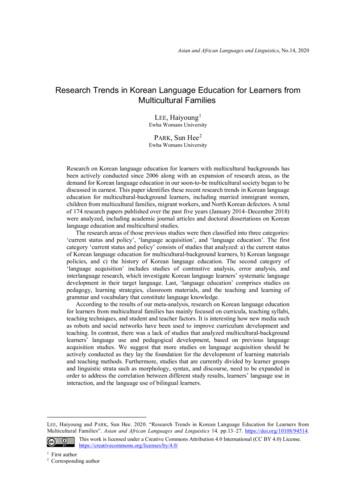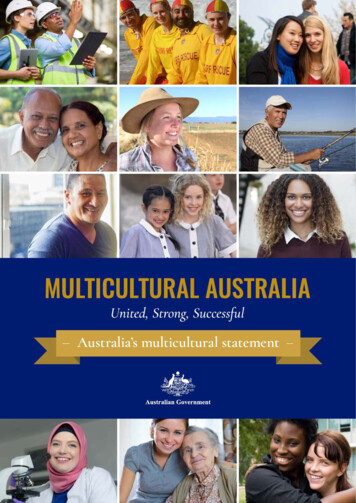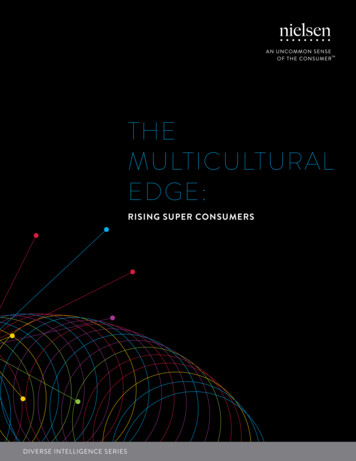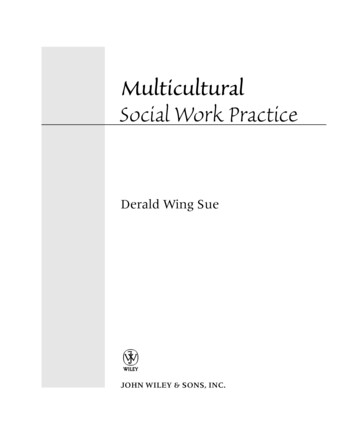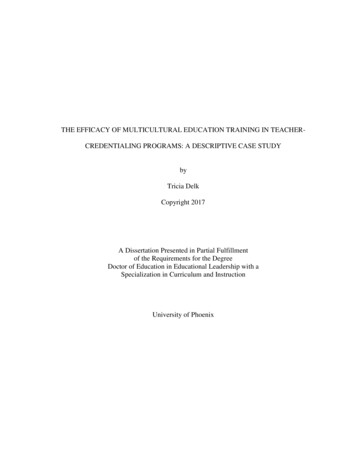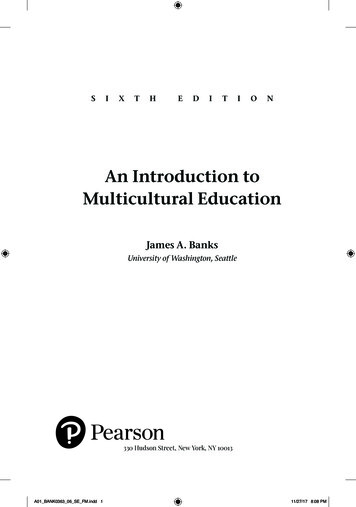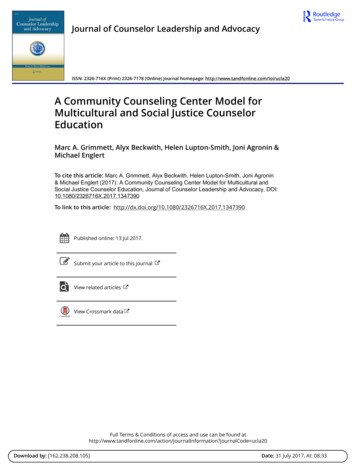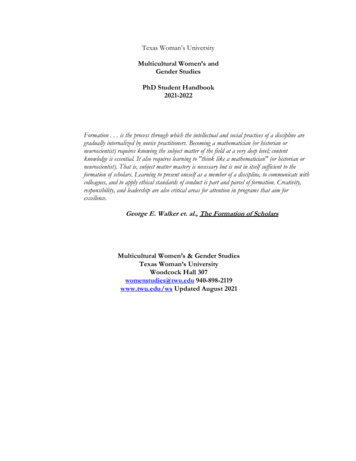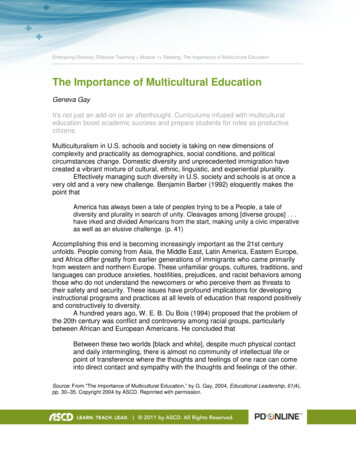
Transcription
Embracing Diversity: Effective Teaching Module 1 Reading: The Importance of Multicultural EducationThe Importance of Multicultural EducationGeneva GayIt's not just an add-on or an afterthought. Curriculums infused with multiculturaleducation boost academic success and prepare students for roles as productivecitizens.Multiculturalism in U.S. schools and society is taking on new dimensions ofcomplexity and practicality as demographics, social conditions, and politicalcircumstances change. Domestic diversity and unprecedented immigration havecreated a vibrant mixture of cultural, ethnic, linguistic, and experiential plurality.Effectively managing such diversity in U.S. society and schools is at once avery old and a very new challenge. Benjamin Barber (1992) eloquently makes thepoint thatAmerica has always been a tale of peoples trying to be a People, a tale ofdiversity and plurality in search of unity. Cleavages among [diverse groups] . . .have irked and divided Americans from the start, making unity a civic imperativeas well as an elusive challenge. (p. 41)Accomplishing this end is becoming increasingly important as the 21st centuryunfolds. People coming from Asia, the Middle East, Latin America, Eastern Europe,and Africa differ greatly from earlier generations of immigrants who came primarilyfrom western and northern Europe. These unfamiliar groups, cultures, traditions, andlanguages can produce anxieties, hostilities, prejudices, and racist behaviors amongthose who do not understand the newcomers or who perceive them as threats totheir safety and security. These issues have profound implications for developinginstructional programs and practices at all levels of education that respond positivelyand constructively to diversity.A hundred years ago, W. E. B. Du Bois (1994) proposed that the problem ofthe 20th century was conflict and controversy among racial groups, particularlybetween African and European Americans. He concluded thatBetween these two worlds [black and white], despite much physical contactand daily intermingling, there is almost no community of intellectual life orpoint of transference where the thoughts and feelings of one race can comeinto direct contact and sympathy with the thoughts and feelings of the other.Source: From ―The Importance of Multicultural Education,‖ by G. Gay, 2004, Educational Leadership, 61(4),pp. 30–35. Copyright 2004 by ASCD. Reprinted with permission.
Embracing Diversity: Effective Teaching Module 1 Reading: The Importance of Multicultural EducationAlthough much has changed since Du Bois's declarations, too much has notchanged nearly enough. Of course, the color line has become more complex anddiverse, and legal barriers against racial intermingling have been dismantled. Peoplefrom different ethnic, racial, and cultural groups live in close physical proximity. Butcoexistence does not mean that people create genuine communities in which theyknow, relate to, and care deeply about one another. The lack of a genuinecommunity of diversity is particularly evident in school curriculums that still do notregularly and systematically include important information and deep study about awide range of diverse ethnic groups. As disparities in educational opportunities andoutcomes among ethnic groups continue to grow, the resulting achievement gap hasreached crisis proportions.Multicultural education is integral to improving the academic success ofstudents of color and preparing all youths for democratic citizenship in a pluralisticsociety. Students need to understand how multicultural issues shape the social,political, economic, and cultural fabric of the United States as well as how suchissues fundamentally influence their personal lives.Conceptions of Multicultural EducationEven though some theorists (Banks & Banks, 2002) have argued that multiculturaleducation is a necessary ingredient of quality education, in actual practice,educators most often perceive it either as an addendum prompted by some crisis oras a luxury. Multicultural education has not yet become a central part of thecurriculum regularly offered to all students; instead, educators have relegated itprimarily to social studies, language arts, and the fine arts and have generallytargeted instruction for students of color.These attitudes distort multicultural education and make it susceptible tosporadic and superficial implementation, if any. Textbooks provide a compellingillustration of such an attitude: The little multicultural content that they offer is oftenpresented in sidebars and special-events sections (Loewen, 1995).Another obstacle to implementing multicultural education lies with teachersthemselves. Many are unconvinced of its worth or its value in developing academicskills and building a unified national community. Even those teachers who are moreaccepting of multicultural education are nevertheless skeptical about the feasibility ofits implementation. ―I would do it if I could,‖ they say, ―but I don't know how.‖―Preparing students to meet standards takes up all my time,‖ others point out.―School curriculums are already overburdened. What do I take out to make room formulticultural education?‖A fallacy underlies these conceptions and the instructional behaviors that theygenerate: the perception of multicultural education as separate content thateducators must append to existing curriculums as separate lessons, units, orcourses. Quite the contrary is true. Multicultural education is more than content; itincludes policy, learning climate, instructional delivery, leadership, and evaluation(see Banks, 1994; Bennett, 2003; Grant & Gomez, 2000). In its comprehensive form,
Embracing Diversity: Effective Teaching Module 1 Reading: The Importance of Multicultural Educationit must be an integral part of everything that happens in the education enterprise,whether it is assessing the academic competencies of students or teaching math,reading, writing, science, social studies, or computer science. Making explicitconnections between multicultural education and subject- and skill-based curriculumand instruction is imperative.It is not pragmatic for K–12 educators to think of multicultural education as adiscrete entity, separated from the commonly accepted components of teaching andlearning. These conceptions may be fine for higher education, where specializationis the rule. But in K–12 schools, where the education process focuses on teachingeclectic bodies of knowledge and skills, teachers need to use multicultural educationto promote such highly valued outcomes as human development, education equality,academic excellence, and democratic citizenship (see Banks & Banks, 2001; Nieto,2000).To translate these theoretical conceptions into practice, educators mustsystematically weave multicultural education into the central core of curriculum,instruction, school leadership, policymaking, counseling, classroom climate, andperformance assessment. Teachers should use multicultural content, perspectives,and experiences to teach reading, math, science, and social studies.For example, teachers could demonstrate mathematical concepts, such asless than/greater than, percentages, ratios, and probabilities using ethnicdemographics. Younger children could consider the ethnic and racial distributions intheir own classrooms, discussing which group's representation is greater than, lessthan, or equal to another's. Older students could collect statistics about ethnicdistributions on a larger scale and use them to make more sophisticatedcalculations, such as converting numbers to percentages and displaying ethnicdemographics on graphs.Students need to apply such major academic skills as data analysis, problemsolving, comprehension, inquiry, and effective communication as they studymulticultural issues and events. For instance, students should not simply memorizefacts about major events involving ethnic groups, such as civil rights movements,social justice efforts, and cultural accomplishments. Instead, educators should teachstudents how to think critically and analytically about these events, proposealternative solutions to social problems, and demonstrate understanding throughsuch forms of communication as poetry, personal correspondence, debate,editorials, and photo essays.Irvine and Armento (2001) provide specific examples for incorporatingmulticultural education into planning language arts, math, science, and social studieslessons for elementary and middle school students and connecting these lessons togeneral curriculum standards. One set of lessons demonstrates how to use Navajorugs to explain the geometric concepts of perimeter and area and to teach studentshow to calculate the areas of squares, rectangles, triangles, and parallelograms.These suggestions indicate that teachers need to use systematic decisionmaking approaches to accomplish multicultural curriculum integration. In practice,
Embracing Diversity: Effective Teaching Module 1 Reading: The Importance of Multicultural Educationthis means developing intentional and orderly processes for including multiculturalcontent. The decision-making process might involve the following steps: Creating learning goals and objectives that incorporate multicultural aspects,such as ―Developing students' ability to write persuasively about social justiceconcerns.‖Using a frequency matrix to ensure that the teacher includes a wide variety ofethnic groups in a wide variety of ways in curriculum materials and instructionalactivities.Introducing different ethnic groups and their contributions on a rotating basis.Including several examples from different ethnic experiences to explain subjectmatter concepts, facts, and skills.Showing how multicultural content, goals, and activities intersect with subjectspecific curricular standards.Virtually all aspects of multicultural education are interdisciplinary. As such, theycannot be adequately understood through a single discipline. For example, teachingstudents about the causes, expressions, and consequences of racism and how tocombat racism requires the application of information and techniques from suchdisciplines as history, economics, sociology, psychology, mathematics, literature,science, art, politics, music, and health care. Theoretical scholarship already affirmsthis interdisciplinary need; now, teachers need to model good curricular andinstructional practice in elementary and secondary classrooms. Putting this principleinto practice will elevate multicultural education from impulse, disciplinary isolation,and simplistic and haphazard guesswork to a level of significance, complexity, andconnectedness across disciplines.Multiculturalism and Curriculum DevelopmentHow can teachers establish linkages between multicultural education and thedisciplines and subject matter content taught in schools? One approach is to filtermulticultural education through two categories of curriculum development:reality/representation and relevance.Reality/RepresentationA persistent concern of curriculum development in all subjects is helping studentsunderstand the realities of the social condition and how they came to be as well asadequately representing those realities. Historically, curriculum designers have beenmore exclusive than inclusive of the wide range of ethnic and cultural diversity thatexists within society. In the haste to promote harmony and avoid controversy andconflict, they gloss over social problems and the realities of ethnic and racialidentities, romanticize racial relations, and ignore the challenges of poverty and
Embracing Diversity: Effective Teaching Module 1 Reading: The Importance of Multicultural Educationurban living in favor of middle-class and suburban experiences. The reality isdistorted and the representations incomplete (Loewen, 1995).An inescapable reality is that diverse ethnic, racial, and cultural groups andindividuals have made contributions to every area of human endeavor and to allaspects of U.S. history, life, and culture. When students study food resources in theUnited States, for example, they often learn about production and distribution bylarge-scale agribusiness and processing corporations. The curriculum virtuallyoverlooks the contributions of the many ethnically diverse people involved in plantingand harvesting vegetables and fruits (with the Mexican and Mexican American farmlabor unionization movement a possible exception). School curriculums thatincorporate comprehensive multicultural education do not perpetuate theseexclusions. Instead, they teach students the reality—how large corporations and thefood industry are directly connected to the migrant workers who harvest vegetablesand pick fruits. If we are going to tell the true story of the United States, multiculturaleducation must be a central feature of telling it.School curriculums need to reverse these trends by also including equitablerepresentations of diversity. For example, the study of American literature, art, andmusic should include contributions of males and females from different ethnic groupsin all genres and in different expressive styles. Thus, the study of jazz will examinevarious forms and techniques produced not just by African Americans but also byAsian, European, and Latino Americans.Moreover, educators should represent ethnically diverse individuals andgroups in all strata of human accomplishment instead of typecasting particulargroups as dependent and helpless victims who make limited contributions ofsignificance. Even under the most oppressive conditions, diverse groups in theUnited States have been creative, activist, and productive on broad scales. The wayin which Japanese Americans handled their internment during World War II providesan excellent example. Although schools must not overlook or minimize the atrocitiesthis group endured, students should also learn how interned Japanese Americansled dignified lives under the most undignified circumstances and elevated theirhumanity above the circumstances. The curriculum should include both issues.RelevanceMany ethnically diverse students do not find schooling exciting or inviting; they oftenfeel unwelcome, insignificant, and alienated. Too much of what is taught has noimmediate value to these students. It does not reflect who they are. Yet mosteducators will agree that learning is more interesting and easier to accomplish whenit has personal meaning for students.Students from different ethnic groups are more likely to be interested andengaged in learning situations that occur in familiar and friendly frameworks than inthose occurring in strange and hostile ones. A key factor in establishing educationalrelevance for these students is cultural similarity and responsiveness (see Bruner,1996; Hollins, 1996; Wlodkowski & Ginsberg, 1995). For example, immigrantVietnamese, Jamaican, and Mexican students who were members of majority
Embracing Diversity: Effective Teaching Module 1 Reading: The Importance of Multicultural Educationpopulations in their home countries initially may have difficulty understanding what itmeans to be members of minority groups in the United States. Students who comefrom education environments that encourage active participatory learning will not beintellectually stimulated by passive instruction that involves lecturing and completingworksheets. Many students of color are bombarded with irrelevant learningexperiences, which dampen their academic interest, engagement, and achievement.Multicultural education mediates these situations by teaching content about thecultures and contributions of many ethnic groups and by using a variety of teachingtechniques that are culturally responsive to different ethnic learning styles.Using a variety of strategies may seem a tall order in a classroom thatincludes students from many different ethnic groups. Research indicates, however,that several ethnic groups share some learning style attributes (Shade, 1989).Teachers need to understand the distinguishing characteristics of different learningstyles and use the instructional techniques best suited to each style. In this scenario,teachers would provide alternative teaching techniques for clusters of studentsinstead of for individual students. In any given lesson, the teacher might offer threeor four ways for students to learn, helping to equalize learning advantages anddisadvantages among the different ethnic groups in the classroom.Scholars are producing powerful descriptions of culturally relevant teachingfor multiethnic students and its effects on achievement. Lipka and Mohatt (1998)describe how a group of teachers, working closely with Native Alaskan (Yup'ik)elders, made school structure, climate, curriculum, and instruction more reflective ofand meaningful to students from the community. For 10 years, the teacherstranslated, adapted, and embedded Yup'ik cultural knowledge in math, literacy, andscience curriculums. The elders served as resources and quality-control monitors oftraditional knowledge, and they provided the inspiration and moral strength for theteachers to persist in their efforts to center the schooling of Yup'ik students aroundthe students' own cultural orientations. In math, for instance, the teachers nowhabitually make connections among the Yup'ik numeration system, bodymeasurements, simple and complex computations, geometry, pattern designs, andtessellations.Similar attributes apply to the work of such scholars as Moses and Cobb(2001), Lee (1993), and Boykin and Bailey (2000), who are studying the effects ofculturally relevant curriculum and instruction on the school performance of AfricanAmerican students.Moses and his colleagues are making higher-order math knowledgeaccessible to African American middle school students by teaching this materialthrough the students' own cultural orientations and experiences. To teach algebra,they emphasize the experiences and familiar environments of urban and rural lowincome students, many of whom are at high risk for academic failure. A key featureof their approach is making students conscious of how algebraic principles andformulas operate in their daily lives and getting students to understand how toexplain these connections in nonalgebraic language before converting thisknowledge into the technical notations and calculations of algebra. Students
Embracing Diversity: Effective Teaching Module 1 Reading: The Importance of Multicultural Educationpreviously considered by some teachers as incapable of learning algebra areperforming at high levels—better, in fact, than many of their advantaged peers.Evidence increasingly indicates that multicultural education makes schoolingmore relevant and effective for Latino American, Native American, Asian American,and Native Hawaiian students as well (see McCarty, 2002; Moll, Amanti, Neff, &Gonzalez, 1992; Park, Goodwin, & Lee, 2001; Tharp & Gallimore, 1988). Studentsperform more successfully on all levels when there is greater congruence betweentheir cultural backgrounds and such school experiences as task interest, effort,academic achievement, and feelings of personal efficacy or social accountability.As the challenge to better educate underachieving students intensifies anddiversity among student populations expands, the need for multicultural educationgrows exponentially. Multicultural education may be the solution to problems thatcurrently appear insolvable: closing the achievement gap; genuinely not leaving anychildren behind academically; revitalizing faith and trust in the promises ofdemocracy, equality, and justice; building education systems that reflect the diversecultural, ethnic, racial, and social contributions that forge society; and providingbetter opportunities for all students.Multicultural education is crucial. Classroom teachers and educators mustanswer its clarion call to provide students from all ethnic groups with the educationthey deserve.ReferencesBanks, J. A. (1994). Multiethnic education: Theory and practice (3rd ed.). Boston:Allyn and Bacon.Banks, J. A., & Banks, C. A. M. (Eds.). (2001). Multicultural education: Issues andperspectives (4th ed.). Boston: Allyn and Bacon.Banks, J. A., & Banks, C. A. M. (Eds.). (2002). Handbook of research onmulticultural education (2nd ed.). San Francisco: Jossey-Bass.Barber, B. R. (1992). An aristocracy of everyone: The politics of education and thefuture of America. New York: Oxford University Press.Bennett, C. I. (2003). Comprehensive multicultural education: Theory and practice.Boston: Allyn and Bacon.Boykin, A. W., & Bailey, C. T. (2000). The role of cultural factors in school relevantcognitive functioning: Synthesis of findings on cultural context, culturalorientations, and individual differences. (ERIC Document ReproductionService No. ED 441 880)Bruner, J. (1996). The culture of education. Cambridge, MA: Harvard UniversityPress.Du Bois, W. E. B. (1994). The souls of black folk. New York: Gramercy Books.Grant, C. A., & Gomez, M. L. (2000). (Eds.). Making school multicultural: Campusand classroom (2nd ed.). Upper Saddle River, NJ: Merrill/Prentice-Hall.Hollins, E. R. (1996). Culture in school learning: Revealing the deep meaning.Mahwah, NJ: Erlbaum.
Embracing Diversity: Effective Teaching Module 1 Reading: The Importance of Multicultural EducationIrvine, J. J., & Armento, B. J. (Eds.). (2001). Culturally responsive teaching: Lessonplanning for elementary and middle grades. Boston: McGraw-Hill.Lee, C. (1993). Signifying as a scaffold to literary interpretation: The pedagogicalimplications of a form of African American discourse (NCTE Research ReportNo. 26). Urbana, IL: National Council of Teachers of English.Lipka, J., & Mohatt, G. V. (1998). Transforming the culture of schools: Yup'ik eskimoexamples. Mahwah, NJ: Erlbaum.Loewen, J. W. (1995). Lies my teacher told me: Everything your American historytextbook got wrong. New York: New Press.McCarty, T. L. (2002). A place to be Navajo: Rough Rock and the struggle for selfdetermination in indigenous schooling. Mahwah, NJ: Erlbaum.Moll, L. C., Amanti, C., Neff, D., & Gonzalez, N. (1992). Funds of knowledge forteaching: Using a qualitative approach to connect homes and classrooms.Theory into Practice, 31(1), 132–141.Moses, R. P., & Cobb, C. E., Jr. (2001). Radical equations: Math literacy and civilrights. Boston: Beacon Press.Nieto, S. (2000). Affirming diversity: The sociopolitical context of multiculturaleducation (3rd ed.). New York: Longman.Park, C. C., Goodwin, A. L., & Lee, S. J. (Eds.). (2001). Research on the educationof Asian and Pacific Americans. Greenwich, CT: Information Age Publishers.Shade, B. J. (Ed.). (1989). Culture, style, and the educative process. Springfield, IL:Charles C. Thomas.Tharp, R. G., & Gallimore, R. (1988). Rousing minds to life: Teaching, learning, andschooling in social context. Cambridge, UK: Cambridge University Press.Wlodkowski, R. J., & Ginsberg, M. B. (1995). Diversity & motivation: Culturallyresponsive teaching. San Francisco: Jossey-Bass.Geneva Gay is a professor of education at the University of Washington, Seattle;ggay@u.washington.edu.
Geneva Gay It's not just an add-on or an afterthought. Curriculums infused with multicultural education boost academic success and prepare students for roles as productive citizens. Multiculturalism in U.S. schools and society is taking on new dimensions of complexity and practicality as demographics, social conditions, and political


